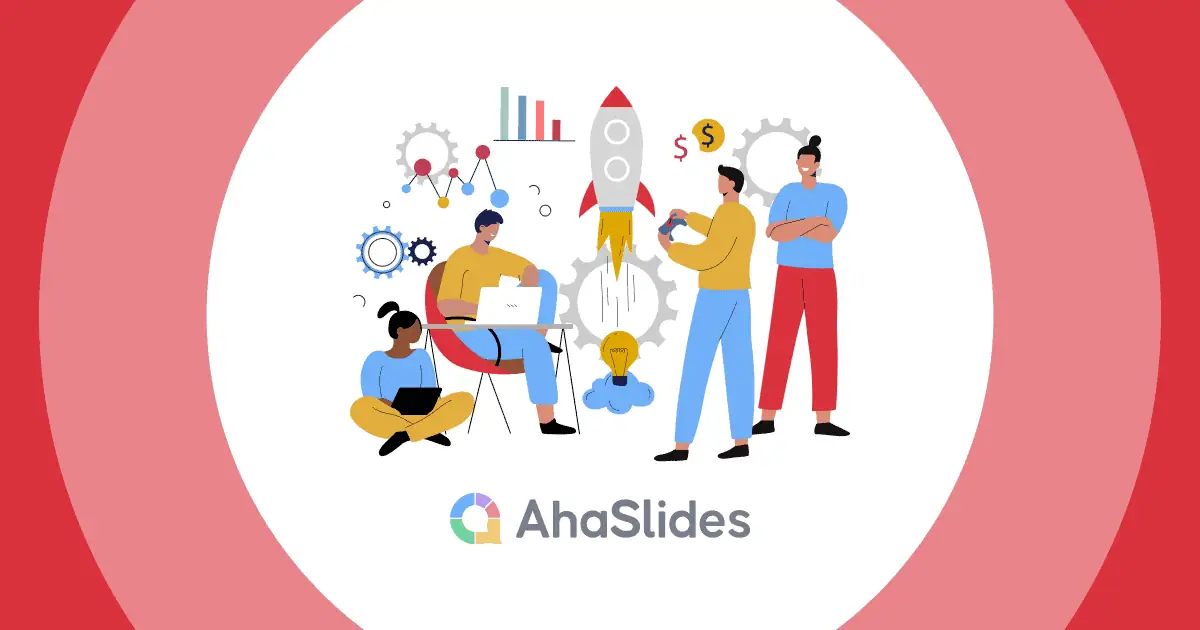マネージャー、人事担当者、従業員のいずれであっても、様々なリーダーシップスタイルとそれが職場に与える影響を理解することは重要です。そして、典型的なリーダーシップスタイルの一つは 独裁的リーダーシップリーダーが部下からの意見やフィードバックを求めることなく、意思決定において完全な権限と統制を行使する、いわゆる「独裁的リーダーシップ」。しかし、独裁的リーダーシップは現代の職場において依然として機能するのでしょうか?
詳しく見てみましょう。
目次
- 独裁的リーダーシップとは?
- 独裁的なリーダーシップの例
- 独裁的なリーダーシップが最も効果的なのはいつですか?
- 独裁的なリーダーシップはまだ機能していますか?
- 独裁的リーダーシップを効果的に活用するには?
- 主要なポイント(要点)
AhaSlidesのその他のヒント

チームを引き付けるためのツールをお探しですか?
AhaSlidesの楽しいクイズでチームメンバーを集めましょう。AhaSlidesテンプレートライブラリから無料のクイズにサインアップしてご参加ください!
🚀無料クイズをつかむ☁️
| 「独裁的」とはどういう意味ですか? | それは、厳しい方法で、指導し、制御するアプローチを意味します。 |
| 独裁的なリーダーの例は何ですか? | アドルフ・ヒトラー、ウラジーミル・プーチン、ヘンリー・フォード、イーロン・マスク、ナポレオン・ボナパルト。 |
独裁的リーダーシップとは?
多くの人は独裁的なリーダーシップスタイルとは何なのか疑問に思っています独裁的リーダーシップ (権威主義的リーダーシップとも呼ばれる) は、リーダーがチームからの情報、意見、またはフィードバックを考慮せずに意思決定を完全に制御および権限を持つリーダーシップ スタイルです。
基本的に、上司はすべての責任を負い、他の人のアイデアや意見を求めません。上司は部下にあまり協力や創造性を求めず、頻繁に命令を出し、部下には疑問を持たずに従うことを期待します。

独裁的リーダーシップの特徴は何ですか?
独裁的なリーダーに共通する特徴は次のとおりです。
- 彼らは、組織で使用されるすべての方法と作業プロセスを担当します。
- 従業員のアイデアや重要なタスクを処理する能力を信頼せず、独自に決定を下すことを好む場合があります。
- 彼女らは通常、厳格で高度に構造化された組織を好みます。
- 彼らは、従業員が確立された原則と基準に厳密に従う必要があります。
- 彼らは、従業員の創造性と革新的な考え方を却下するかもしれません。
独裁的なリーダーシップの例
以下は、独裁的なリーダーシップの実際の例です。
1/ スティーブ・ジョブズ
スティーブ・ジョブズは独裁的なリーダーのよく知られた例です。AppleのCEO在任中、彼は会社の意思決定プロセスを完全に掌握し、要求が厳しく批判的な経営スタイルで知られていました。彼はAppleをどうしたいのかという明確なビジョンを持ち、そのビジョンを実現するためには不人気な決断も恐れませんでした。

彼は細部へのこだわりと完璧へのこだわりで有名で、しばしば従業員に多大なプレッシャーをかけました。 彼はまた、彼の高い基準を満たさなかった従業員を非難し、軽蔑することでも知られていました. この管理スタイルは、従業員の士気の低下と Apple での高い離職率につながりました。
彼は、共感の欠如と、Apple で恐怖の文化を作り出したことで批判されました。 彼の死後、同社はより協調的で包括的なリーダーシップ スタイルへと大きな文化的変化を遂げました。
2/ ウラジーミル・プーチン
独裁的指導者の好例といえば、ウラジーミル・プーチン大統領が挙げられる。彼は権威主義的な指導スタイルを用いて、ロシアとその政治体制に対する支配力を強化してきた。外国の脅威からロシアの利益を守ることができる、厳格かつ決断力のある指導者として、確固たる評判を築いてきた。プーチン大統領の政策は、ロシア経済の安定と世界的な影響力の拡大にも寄与した。

しかし、プーチン大統領の指導スタイルは非民主的で、政治的反対意見を抑圧していると批判されている。また、政治的反対派の弾圧やLGBTQの権利の抑圧など、人権侵害の疑いもかけられている。
3/ ジェフ・ベゾス
アマゾンの創業者であるジェフ・ベゾスも独裁的なリーダーの特徴を持っています。

例えば、ベゾスは非常に現実的な人物として知られ、アマゾンの日常業務に深く関わっています。独裁的なリーダーとして知られる彼は、マイクロマネジャー(細かいことを細かく指示する人)として知られ、従業員の決定にしばしば疑問を投げかけ、高い基準を満たすようプレッシャーをかけます。また、チームに相談することなく一方的に決定を下すことでも知られています。
それにもかかわらず、ベゾスは長期的に考え、喜んでリスクを冒すことで、Amazon を世界で最も成功した企業の XNUMX つに作り上げました。
4/ ミリタリー
わかりやすく説明すると、軍隊は独裁的なリーダーシップを適用する典型的な組織です。

軍隊は、 階層構造 そして、その成功に不可欠な指揮系統。 したがって、独裁的なリーダーシップは、危機的な状況で迅速かつ決定的な意思決定を確実にするためによく使用されます。
軍隊では、命令は最高司令官から発せられ、階級を通じて伝達されます。下級職員は、たとえ命令に異議があっても、疑問を抱くことなく命令に従わなければなりません。軍隊の厳格な組織構造と規律の重視は、命令が迅速かつ効率的に実行されることを保証しています。
独裁的なリーダーシップが最も効果的なのはいつですか?
これまで見てきたように、多くの偉人は権威主義的なリーダーシップスタイルを適用して、全人類に多くの成果をもたらしています。 独裁的なリーダーシップは次のような状況で効果的です。
1/ 迅速な意思決定
独裁的なリーダーは、多くの場合、迅速かつ決定的な決定を下すことができます。 彼らは最適な戦略を構築し、従業員に彼らの命令に従うように強制するからです. その結果、ビジネスはプロジェクトが遅れたり、明確な方向性が必要な状況に陥ったりすることはありません。
2/ 説明責任
独裁的なリーダーはすべての選択を行うため、多くの場合、自分の決定と行動に対して責任を問われます。 これは、リーダーが責任感と当事者意識を生み出すのに役立ち、組織に利益をもたらし、従業員に安心感を与えることができます。
3/安定性を維持する
独裁的なリーダーシップは、ルールやポリシーが厳格に遵守されるため、安定した予測可能な職場環境を作り出すことができます。これにより、従業員は割り当てられたタスクを期限通りに完了し、仕事の滞留を回避する意欲が高まります。
4/ 経験やスキルの不足を補う
独裁的なリーダーは、チーム メンバーの経験不足やスキルのギャップを補うことができます。 チームに明確な指示、監督、および方向性を提供することで、ミスを回避し、より効率的に目標を達成するのに役立ちます。

独裁的なリーダーシップはまだ機能していますか?
かつては効果的だった独裁的なリーダーシップですが、現代の企業では人気が下がり、効果も薄れつつあります。多くの組織が、従業員のエンゲージメント、エンパワーメント、そして創造性を重視する、より包括的で協調的なリーダーシップスタイルを採用しています。独裁的なスタイルでは、その欠点のために実現が困難だったこれらの要素です。
1/ 創造性とイノベーションを制限する
独裁的なリーダーは、他者からの意見を考慮せず、フィードバックも必要とせずに意思決定を行うことがよくあります。その結果、新しいプロジェクトが検討・推進されないため、チームの創造力と革新力は制限され、成長と改善の機会を逃すことにつながります。
2/ 従業員の仕事の満足度を下げる
権威主義的なリーダーシップスタイルは、従業員のアイデアや取り組みが簡単に却下されるため、過小評価され、評価されていないと感じさせる可能性があります。これは、従業員の離職、不満、士気の低下といった感情につながり、従業員の仕事への満足度と生産性を低下させる可能性があります。
3/ 従業員のエンパワーメントの欠如
マネージャーがチームメンバーの参加なしにすべての決定を下す独裁的な経営は、従業員のエンパワーメントの欠如につながります。これにより、従業員は自分の仕事に主体性を持ち、組織の成功に貢献しているという意識を持てなくなる可能性があります。
4/従業員の健康への悪影響
ルールを厳格に守り、仕事に発言権を持たないと、従業員はプレッシャーを感じ、退屈し、不健全な職場環境を生み出す可能性があります。 多くの場合、独裁的なリーダーは従業員の燃え尽き症候群やその他の問題を引き起こす可能性があります。 職場でのメンタルヘルス.
5/ 成長と発展の機会を制限する
独裁的なリーダーは、チーム メンバーのスキルや能力の開発にあまり注力しない可能性があり、組織内の従業員の成長の機会を制限する可能性があります。 これにより、離職率が高くなり、優秀な人材を引き付けるのが難しくなる可能性があります。 その結果、企業の市場競争力が損なわれます。
全体として、独裁的なリーダーシップにはプラス面とマイナス面の両方があり、その有効性はしばしばそれが適用される状況に依存します。 --- 明るい面としては、独裁的なリーダーは迅速かつ決断力のある意思決定を行えることが多いです。これは、時間が極めて重要な状況や、重要な意思決定にリーダーの専門知識が求められる場合に有効です。さらに、独裁的なリーダーは組織を厳格に統制し、ミスを確実に防止することができます。これは、医療や航空業界のような高リスクの業界では特に重要です。 ただし、独裁的なリーダーは、権威主義的または支配的であるなどの否定的な結果をもたらす可能性もあり、組織全体ではなく、自分自身または少数の内部関係者のグループに利益をもたらす決定を下しやすくなります。 これにより、従業員の憤りや士気が低下し、従業員の能力開発や組織全体に影響を与える可能性があります。 独裁的なリーダーシップには、潜在的な利点と欠点の両方があることを認識することが重要です。 特定の状況では適切な場合もありますが、常に最善のアプローチとは限らず、必要に応じて他のリーダーシップ スタイルとのバランスを取る必要があります。 |
独裁的リーダーシップを効果的に活用するには?
昔ながらの「災難」的な独裁的リーダーにならないように、今日の職場に関係のある権威主義的リーダーシップをうまく活用するための以下のヒントを確認してください。
1/ アクティブリスニング
アクティブリスニング は、たとえ独裁的なマネージャーであっても、すべてのリーダーが実践すべきコミュニケーション手法です。 従業員が伝えているメッセージを理解するには、つながりを保ち、完全に集中する必要があります。 これは、従業員に対する信頼を築き、従業員との関わりを改善し、従業員の生産性を向上させ、管理の質を向上させるのに役立ちます。
2/ 共感を示す
共感とは、他人の気持ちを理解し、共有する能力です。 従業員に共感することは、リーダーが信頼を築き、コミュニケーションを改善し、前向きな職場環境を作り出すための重要なツールとなります。
ですから、従業員の立場に立って考えてみましょう。自分がその従業員の立場だったらどう感じるかを考えてみましょう。そうすることで、相手の視点を理解し、感情を認識し、共感を示すことができるようになります。
従業員の懸念事項を特定したら、できる限りのサポートを提供してください。これには、ガイダンスやリソースの提供、あるいは単に話を聞いて励ますことも含まれます。
3/ 褒めて認める
従業員の努力を称賛し、認めることは、前向きな職場環境を構築し、士気を高め、生産性を高めるために不可欠です。 従業員が感謝されていると感じると、モチベーションとエンゲージメントを感じる可能性が高くなり、仕事の満足度と定着率が向上します。
従業員のやる気を引き出すために使用できるヒントをいくつか紹介します。
- 具体的に: 「よくやった」や「よくやった」と言うだけでなく、従業員が何をうまくやったかを具体的に伝えましょう。例えば、「あのプロジェクトの進め方、本当に感謝しています。おかげで期限に間に合いました。」
- タイムリーに: 従業員の努力を認めるのに、あまり時間をかけすぎないでください。すぐに認めることで、あなたが彼らの貢献に注目し、感謝していることが伝わります。
- さまざまな方法を使用します。 従業員を表彰するさまざまな方法を検討してください。たとえば、直接会ったり、電子メールを使用したり、会議やニュースレターで公開したりします。 これにより、チームの全員が従業員の貢献を認識できるようになります。
- 仲間の認識を促す: 従業員同士が互いの努力を認め合うように促すことで、前向きな職場環境と認め合う文化を育むこともできます。
4/ 従業員の自己啓発を支援する
従業員の成長を支援することは、従業員の長期的な成功と組織の成功にとって不可欠です。 専門的な成長と能力開発の機会を提供することで、従業員は自分の仕事に価値を感じ、意欲を持ち、熱心に取り組んでいると感じることができます。 従業員の成長を支援するいくつかの方法を次に示します。
- ソフト スキル トレーニング プログラムを提供します。 ソフトスキルトレーニング 従業員が新しいスキルと知識を習得して、より良い仕事をするのを助けることができます。 これには、セミナー、コース、オンライン トレーニング、メンタリング、またはコーチング プログラムが含まれる場合があります。
- キャリア開発を奨励する: キャリアコーチング、スキル評価、能力開発計画などのリソースを提供することで、従業員が自分のキャリア成長に責任を持つよう奨励します。 これにより、従業員は強みと改善すべき領域を特定し、キャリア成長の道筋を立てることができます。
- 従業員の実践を支援 自習型学習: 従業員のニーズを特定し、従業員が自分のペースに最適な学習プログラムを見つけるのを支援します。 e ラーニング コースを提供したり、オンラインで授与される認定を取得するための予算を提供したりできます。
5/ 従業員のフィードバックを集める
従業員からのフィードバックを得ることは、前向きな職場環境を作り、従業員のエンゲージメントを向上させるために不可欠です。 これを行うXNUMXつの方法は、 あはスライド 作成して従業員からフィードバックを収集する ライブ投票, ライブQ&A さまざまなトピックに関する具体的な意見を収集します。 特にリアルタイムのフィードバックにより、会議、イベント、またはプレゼンテーション中に従業員から即座にフィードバックを得ることができます。
さらに、AhaSlidesでは匿名でのフィードバックが可能です。これにより、従業員は意見を曲げられることを恐れることなく、率直な意見を共有しやすくなります。これにより、より正確で誠実なフィードバックを収集できるようになります。
従業員からのフィードバックを得ることで、改善点を特定し、従業員との信頼関係を構築し、よりポジティブな職場環境を構築することができます。従業員のエンゲージメントと定着率を向上させるには、従業員の声に耳を傾け、フィードバックに適切な対応を取ることが不可欠です。

主要なポイント(要点)
結論として、独裁的なリーダーシップは、迅速な決定が必要な緊急事態やプレッシャーのかかる状況など、特定の状況では効果的なリーダーシップ スタイルになる可能性があります。 しかし、長期的には従業員の士気やエンゲージメントに悪影響を及ぼし、高い離職率や不健康な職場環境につながる可能性もあります。
独裁的なリーダーシップの欠点を認識し、従業員に権限を与え、コラボレーションを促進する、より民主的または参加型のリーダーシップ スタイルを検討することが重要です。 そうすることで、組織はイノベーション、創造性、従業員の関与を促進するよりポジティブな職場環境を作り出し、より大きな成功と成長につながることができます。
よくある質問
ご質問がありますか? お答えします。
他人に相談せずに意思決定を行うことに重点を置くリーダーシップ スタイルはどれですか?
どのグループが独裁的なリーダーシップスタイルを採用するでしょうか?
独裁的な意思決定とは何ですか?
独裁的な意思決定では、リーダーは通常、独自に意思決定を行い、それをチームや部下に伝え、その決定に疑問や異議を唱えることなく、従順な行動を期待します。このスタイルはトップダウン型のアプローチを特徴としており、リーダーがすべての意思決定権を握り、その決定事項の実施と実行に関して権限を行使します。
独裁的な意思決定は、危機や緊急事態の際に迅速な決定を下す場合や、リーダーが他の人にはない専門知識や技能を持っている場合など、特定の状況では効果的です。








